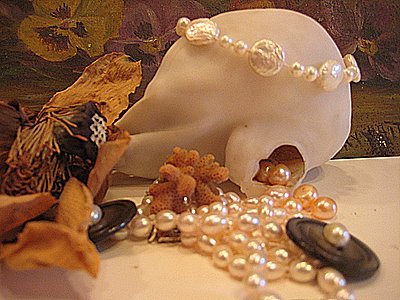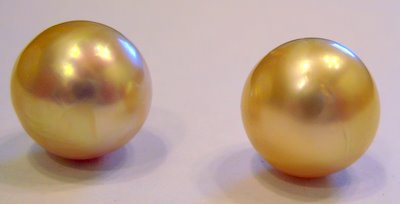|
Pearl Information
Enjoy this pearl information. Have you ever wondered if cultured pearls are real pearls? You are not alone.
 Pearls Pearls Pearls (Giant Clam Pearl & Freshwater Pearls)
by: Kari Anderson
So what exactly is a pearl? Cultured, natural, akoya, freshwater....do these terms confuse you?
Don't worry, you're not alone....reading this pearl information will help you understand.
We all understand cultured anything else...after all we don't usually find our strawberries in the forest anymore. Our farm is filled with wild parsnips...but if I want parsnips I buy them at the grocery store....they're much bigger and better developed.
Well, pearls are much the same way...either "wild" or "cultured".
"Wild" pearls are called "natural" pearls. Although, often the term "natural" is also used to specify whether or not the color is natural....so keep that in mind.
Natural pearls, the only kind available centuries ago, are rare and valuable...if available at all. The country of Bahrain, however, still deals in natural pearls...in fact, selling of cultured pearls is illegal there.
Remember seeing those old painting of the queens all draped with long ropes of pearls? Those were most likely "natural pearls," although, even back then, they had ways of making artificial pearls.
Natural pearls are still being found all over the world...even 10 miles from my home here in eastern Iowa, people find natural freshwater pearls in the Mississippi River.
Ahhhhh, "freshwater"....now just what does that mean? That's an easy one. Any pearl found in a body of water that's freshwater, like a lake, river, creek, is a "freshwater" pearl.
"Sea pearls" or "saltwater pearls" are found in bodies of saltwater such as oceans, seas, or gulfs.
So what exactly does "cultured" mean? Is it a "real" pearl?
Well....are the strawberries you buy at the grocery store "real strawberries"?
Yes, "cultured pearls" are "real pearls."
Say someone really liked strawberries, but could never find enough of them in the woods, or the ones they found were too small, or too tasteless?
That person is glad that some intelligent folks figured out how to propagate strawberries and develop them into large, sweet, red gems that explode with flavor.
Cultured pearls happen much the same way...through planning, development and farming techniques. Pearl farming has been developed from years of researching pearl information.
My son planted strawberry seeds this year in a planter. Without the seeds, no strawberry plants would have sprouted.
Without a little help most mussels or oysters won't grow a pearl either.
But there are ways to "start a pearl" growing in these mollusks (or molluscs). (Mollusks are any of numerous chiefly marine invertebrates of the phylum Mollusca, typically having a soft unsegmented body, a mantle, and a protective calcareous shell and including the edible shellfish and the snails.)
Several people studied pearl information and worked on figuring out to start a pearl growing, but Mikimoto is often the man credited with carrying the process to full development.
It's similar to taking a plant cutting. Has your mother ever visited a friend's garden who shared a "slip" of geranium with her so she could start her own plant?
Well, in a similar way, to get a cultured pearl started, the mollusk needs a piece of mantle tissue from another mollusk.
A tiny piece of mantle tissue from a mussel or oyster is inserted into a live mollusk which is set back into a body of water. A "pearl sac" is developed around the piece and the mollusk begins coating the tissue with layers of nacre....the substance of pearls....making a pearl.
Often, for both sea and freshwater pearls, along with the tissue is placed a shell bead which can be a variety of shapes. The mollusk then coats this bead with pearl substance. This way, the shape of pearl can be controlled.  Golden South Sea Cultured Pearls
Those big beautiful round lustrous pearls that have always been popular are often mostly a shell bead inside with a coating of pearl on the outside. Are they real pearls? Yes! But be sure to buy from a reputable seller to make sure the coating is thick enough not to peel or wear off. In this regard the more pearl information you have the better a shopper you will be.
An akoya pearl, by the way, is a pearl from the akoya oyster (Pinctada Fucata Martensii), which lives in salt water.
Most freshwater pearls from Asia are nearly solid nacre...you don't need to worry about them peeling.
Because more pearls can be grown in freshwater mussels than saltwater oysters, the price is often much more affordable.
Saltwater, freshwater, natural or cultured pearls...all are amazing gifts from God...and the lowly, humble mollusk.
Enjoy those pearls! The mollusks worked hard to make them for you.
Learn more pearl information here.
|











